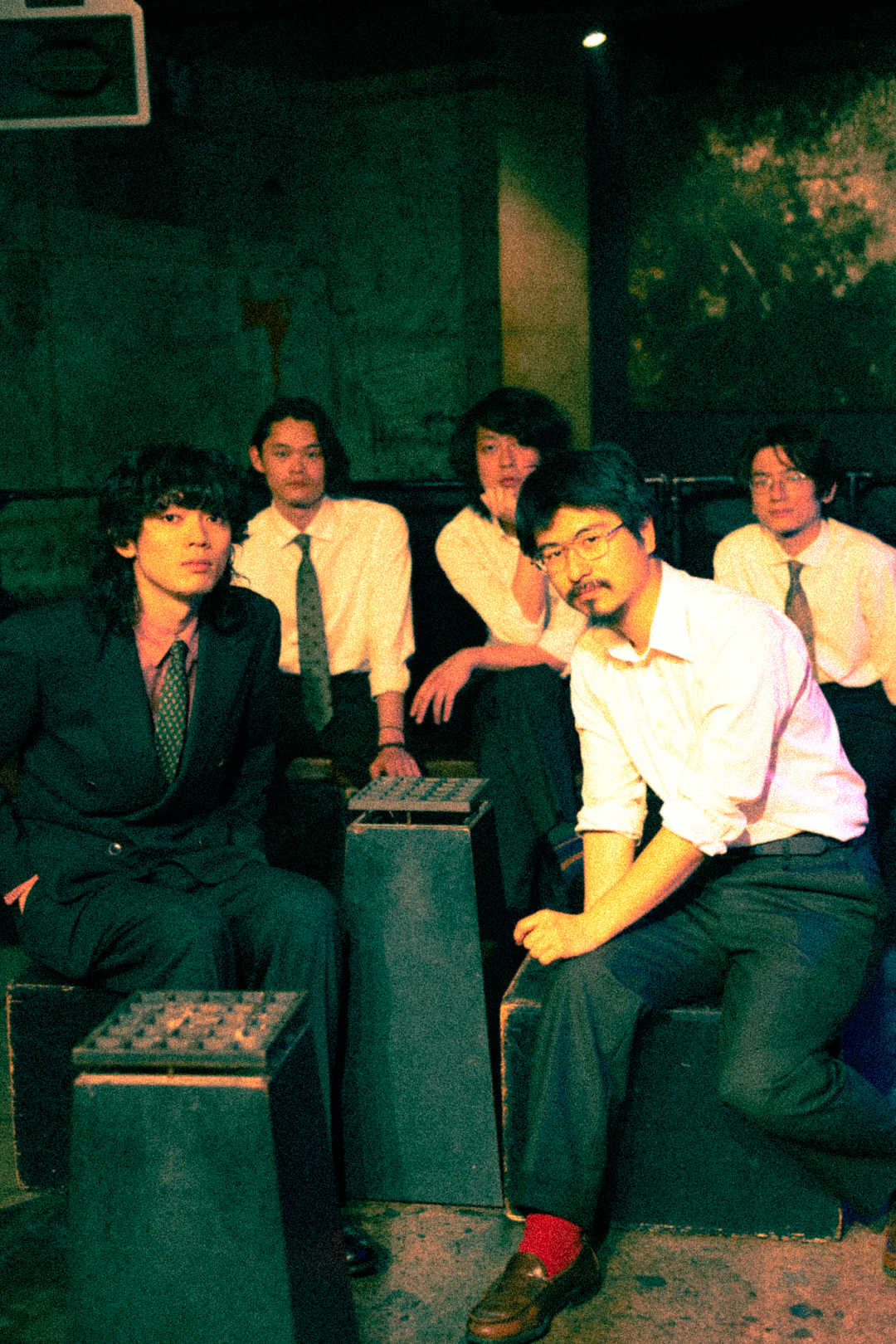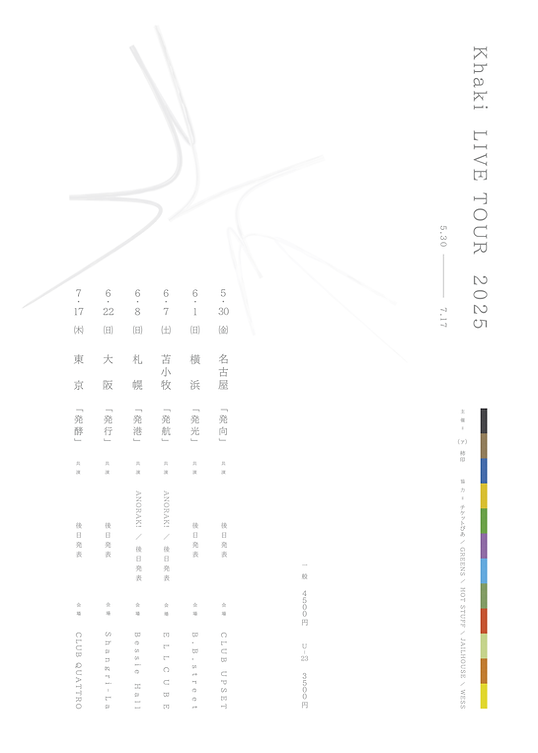Khaki is a five-piece band that has garnered attention for their unique musicality and keen sense of beauty. We asked them about their thoughts and feelings behind the creation of their second album “Hakko” and their upcoming tour.

What is “Immersive Art Rock”?
——What is the meaning behind the expression “Immersive Art Rock” that Khaki advocates?
Hiroto Nakashio (Vo, Gt.): It’s pop music with a little bit of discomfort.
Naoto Hirakawa (Vo, Gt.): We just advocate it by chance and have no particular intention. However, as long as we are advocating it, we have a sense of responsibility and satisfaction in creating songs that can be interpreted as such and that are different from others. I am not sure if I will continue to advocate this in my next album or not.
Taichi Shimokobe (Ba.): I am not sure since it is a slogan created by a third party. I don’t think it’s particularly immersive or artistic.
Takumi Hashimoto(Dr.): I don’t know. I don’t know either.
Hiroki Kuroha(Key.): I don’t know either.
About second album “Hakko”
——What is the overall theme or concept of this album?
Nakashio: It’s the awareness of putting a lot of persistence into it.
Kuroha: “Sexuality,” I heard.
——Which songs did you put special emphasis on/are you particularly attached to?
Nakashio: For “Harmful Insects,” I spent a lot of time mixing and mastering to execute the idea.
Hirakawa: At the stage when Nakashio’s song “Civilized Child” was being created, I had no vision of what kind of song I wanted to create next, and I was quite stuck, so when I managed to complete the song “Angel”, I felt that I could move on since it was completed anyway.
Shimokobe: I think we started with two songs, “Civilized Child” and “Angel,” and then we thought about what kind of songs we wanted to have in response to them. I personally listen to the song “Ark of Talent” a lot because I feel that it is one of the points where Kuroha (keyboardist) reached in his songwriting.
Hashimoto: Personally, I think this album is an album that contains all of the current Khaki. I recorded all the songs while heaving and groaning.
Kuroha: “Ark of Talent”. But I feel like I put too much effort into it.
——How and in what situations would you like listeners to hear your music?
Nakashio: I think it would be interesting if it blended into everyone’s daily life.
Hirakawa: Nothing in particular, but it would be cool if people listened to it when they were fed up with something.
Shimokobe: It would be good to listen to it while riding a train or walking around town.
Hashimoto: Listen to it however you like. This album contains songs with many colors. They will surely accompany you in various situations and feelings. Maybe.
Kuroha: I leave it up to you.
Khaki in vision
——How did you come to release the preview video?
Hirakawa: Since it had been decided that we would ask writer Masatsugu Ono to write the liner notes, we were all wondering if there were other ways to enjoy the time leading up to the release and to promote the album other than through writing. At that time, Hashimoto and our manager were referencing a video of a Japanese comedian introducing sake, and I watched it and immediately thought of the picture of the “what’s in my bag?” video on YouTube. I first wanted to capture the image of a person facing only inorganic music.
Then, I asked Mr. Yoshida of Triple Fire and Mr. Onoue of aldo van eyck to cooperate with me as musicians in the end, but listeners can get fresh impressions not only from the world of musicians, but also from people who do not have much direct contact with Khaki or who are active in other genres. I thought it would be interesting to make a video without being able to listen to the soundtrack, and that’s how this project came about.
Hashimoto: We often receive comments in writing, but it is difficult to leave a lasting impression with just that, and the comments we receive are easily passed along on social networking sites…. I thought that a video would leave a lasting impression on the audience and convey the real reactions of the performers when they first heard this work. I also thought that by having not only musicians but also people from a wide range of genres perform, we would be able to reach people who are unfamiliar with Khaki and do not usually listen to bands.
——What values and aims do you have for video production?
Hashimoto: In Khaki’s music video, we tried to include a close-up of the faces in order to “make people remember their faces anyway. I was conscious of the location and composition of the video to match the image of the song, smooth cuts that do not interrupt the flow of the song, sound framing, and making sure to show everyone in the chorus part, which will be clipped on SNS for advertising purposes.
Khaki’s immersive space of live performance
——What are the themes and thoughts behind this tour? I am also interested in the perspective from which the counterparts were chosen.
Nakashio: I would like to put a lot of effort into this release. And we are happy to be able to work with people we respect.
Hirakawa: The members of the band had to think about who to play with so that we could reflect the various musical tastes of each member, which is part of Khaki’s musicality, and as a result, we were able to invite musicians who are active in various musical styles and whom we respect.
Shimokobe: Since this is a tour with the album in tow, the songs from “Hakko” will be the main focus. As for our opponents, we invited people that each member thinks are good.
Hashimoto: We invited some cool bands. I will do my best not to lose to them.
Kuroha: Anyway, this is our first tour, so I think it is the result of a lot of thinking about how to make it fun.

——Can you tell us about your current thoughts and how you are preparing for your appearance at Fuji Rock?
Nakashio: I have never been to Fuji Rock before, so I am looking forward to it.
Hirakawa: It is the pinnacle of Japanese rock festivals, and of course I have always longed to play there, so I am very happy to be able to perform there. I have never been to one before, so I am looking forward to having an unbelievable time throughout the three days.
Shimokobe: I have personally been to this festival many times, so I am looking forward to experiencing the atmosphere of the venue as a performer.
Hashimoto: It looks hot, but I’ll do my best.
Kuroha: I will try to be careful of insects.
Interest in Asia
——I believe this interview will be read by music fans from other Asian countries. Are there any countries or regions that you are particularly drawn to musically?
Nakashio: Recently I’ve been into Korean music, and there are a lot of great artists there, including Kim Oki.
Hirakawa: I don’t know much about it, but I feel that the Korean HIPHOP scene seems to have a lot of music that I suddenly find “cool” when I hear it, and I would like to become more familiar with it.
Shimokobe: I don’t know if this is an appropriate answer, but I like Korean idols and listen to them a lot. I have been listening to SUMIN a lot lately in the form of tracing its composer.
Hashimoto: Turkey. I would like to visit there once because it is famous for cymbals.
Kuroha: Japan. I am very familiar with Japan.
Khaki’s Art of Self-Direction
——What kind of self-promotion are you aware of in your band’s activities?
Nakashio: I would like to do something interesting.
Hirakawa: Since we are running our own office, we have a much smaller budget to spend on advertising than musicians affiliated with major firms, and I think there is also a sense of tension that the advertising we do can never fail. We often think carefully with Khaki and his staff to come up with a plan that everyone will enjoy quite a bit.
One related thing that has stayed in my mind is when I met Daigo Iizuka, a broadcaster who also participated in the audiovisual program, about a year ago and asked him, “You have created a ridiculous number of interesting projects, how do you do it?” I asked him a rather dumb question, “How do you make so many interesting projects?” He replied, “A group of adults get together and think very, very hard. I feel that this is reflected not only in the advertisements but also in our songwriting.
However, there are various opinions these days, so I am also anxious about whether we should continue to do things on our own.
Hashimoto: When we send out information via SNS, we are conscious of the text and layout so that the audience can understand the content at a glance. If we are going to release a work or hold an event, we try to promote it in such a way that it becomes a topic of conversation and that the audience is interested in it, rather than just announcing it. Of course we are confident in our work, so we always think about how we can spread the word about it.
Kuroha: I’m not very good at that kind of thing, so I enjoy it while being careful not to get in the way.
Unstoppable Khaki, the next achievement
——Please tell us about your future goals as an artist and the point you would like to reach.
Nakashio: I am not so sure now. I want to do what I want to do.
Hirakawa: I am not particularly interested in anything more than continuing to make great music and having wonderful experiences that I never imagined would come along with it. If we could share even a little of that with the audience, I don’t think it would be such a wonderful thing.
Shimokobe: Probably all the members are quite bored, so I think it is best if we can keep ourselves fresh.
Hashimoto: My personal goal is to hold a solo exhibition within the year.
Kuroha: I would like to visit the polar regions (Antarctica and the North Pole).
Khaki continues to draw contours of sound and words with his unique sensibility and distance, and his second album “Hakko” is both his current location and a conduit to landscapes yet to be seen. In the words spoken without any tension, there is a will to move forward to the next step, while accepting the present. How will Khaki’s music expand in the future? What kind of scenery will he show us? We hope for the best.
